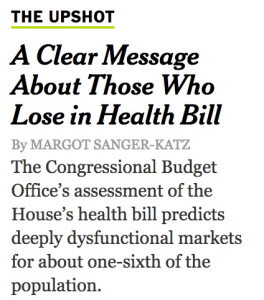By James Kwak The Congressional Budget Office’s assessment of the Republican health care plan, as passed in the House, is out. The bottom line is that many more people will lack health coverage than under current law—23 million by 2026—even though the bill allows states to relax the essential health benefits package, which should in theory attract younger, healthier people. This is not a surprise. I just want to comment on the role of markets in all of this, which I think is not fully understood. For example, the Times article by the very up-to-speed Margot Sanger-Katz explains that the American Health Care Act of 2017 will make markets “dysfunctional.” This is consistent with the rosy view that many people, particularly centrist Democrats, have of health care: if we could only get
Topics:
James Kwak considers the following as important: economism, health care, Health Insurance, syndication, Trumpcare
This could be interesting, too:
Dean Baker writes Health insurance killing: Economics does have something to say
Nick Falvo writes Homelessness planning during COVID
Nick Falvo writes Report finds insufficient daytime options for people experiencing homelessness
Nick Falvo writes Women’s homelessness
By James Kwak
The Congressional Budget Office’s assessment of the Republican health care plan, as passed in the House, is out. The bottom line is that many more people will lack health coverage than under current law—23 million by 2026—even though the bill allows states to relax the essential health benefits package, which should in theory attract younger, healthier people. This is not a surprise.
I just want to comment on the role of markets in all of this, which I think is not fully understood. For example, the Times article by the very up-to-speed Margot Sanger-Katz explains that the American Health Care Act of 2017 will make markets “dysfunctional.”

This is consistent with the rosy view that many people, particularly centrist Democrats, have of health care: if we could only get markets to behave properly (correct for market failures, to use the jargon), everything would be great.
But that’s not how markets work.
The CBO report specifically discusses the “stability of the health insurance market,” which they define in these terms: the market is unstable “if, for example, the people who wanted to buy coverage at any offered price would have average health care expenditures so high that offering the insurance would be unprofitable.” In their analysis, instability will result in some states that waive both the essential health benefits package and the prohibition on medical underwriting (charging premiums based on applicants’ health status). In that case, healthy people will choose cheaper policies with less comprehensive benefits. Only sick people will buy more generous policies, which will soon become apparent to insurers, who will raise premiums (to account for sick people’s higher expected health care costs), which will make insurance unaffordable for the people who need it most.
This is all true. But that’s not a dysfunctional market. That’s just a market.
It’s a common characteristic of markets that suppliers offer different products, each designed to meet the needs of a different segment of buyers. In fact, this is generally considered a positive feature of markets. Market completeness—meaning, roughly speaking, that all possible goods and services can be traded—is an assumption of some of the most important theorems in economics.
In the example above, health insurers are offering one low-frills, low-priced product and another gold-plated, high-priced product. In most contexts, we would consider this a good thing. Can you imagine if everyone had to buy the same Toyota Camry? Isn’t it good that people with low incomes can buy a Honda Fit, while those with high incomes can buy a BMW M6? And we don’t worry about the fact that most people can’t afford an M6.
Say you have treatable cancer. Your expected medical costs are $50,000 for the next year. In a functioning market, your health insurance policy should cost about $60,000. (The extra $10,000 covers administrative costs and the cost of capital.) It’s still insurance, because you’re protected against the risk that your medical costs will unexpectedly be $100,000. That’s the right product for you: it’s the one you need, and it’s priced appropriately. That’s what markets are supposed to provide. The world where you can buy an individual policy for $3,000 because the insurer doesn’t know you have cancer, or because Obamacare prohibits the insurer from using that information—you may get treatment in that world, but only because we prevent the market from functioning the way it’s supposed to.
The core problem, of course, is that cancer treatment isn’t like a BMW that can go 150 miles per hour; we’re not willing to call it a luxury that most people can’t afford. Most people can’t afford to pay $60,000 for a health insurance policy. A world in which sick people are priced out of health care is not a world we want to live in. And that’s why markets are the wrong way to distribute essential health care (something I discuss at much greater length in Economism.)
We think all people should get decent care regardless of their income. That means we have to have a basic minimum available to everyone, and people shouldn’t have to pay more for it than they can afford. There’s a name for this system: single payer. We may need a long time to get there. But in the meantime, let’s stop pretending that markets can solve our problems, if only we could somehow make them function properly.
